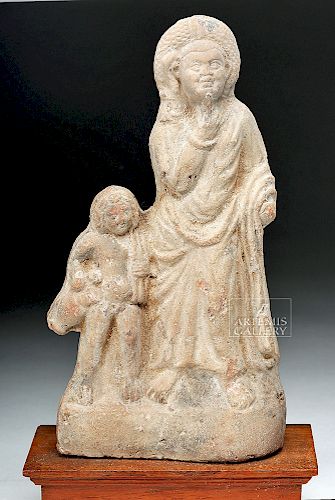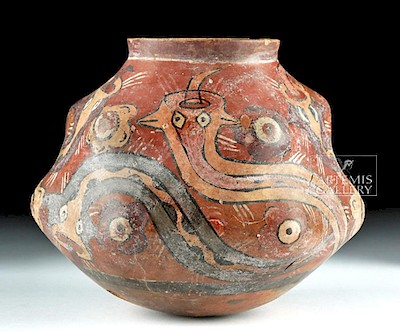Romano-Egyptian Terracotta Figure with Child
Lot 15
About Seller
Artemis Gallery
686 S Taylor Ave, Ste 106
Louisville, CO 80027
United States
Selling antiquities, ancient and ethnographic art online since 1993, Artemis Gallery specializes in Classical Antiquities (Egyptian, Greek, Roman, Near Eastern), Asian, Pre-Columbian, African / Tribal / Oceanographic art. Our extensive inventory includes pottery, stone, metal, wood, glass and textil...Read more
Categories
Estimate:
$1,500 - $2,250
Absentee vs Live bid
Two ways to bid:
- Leave a max absentee bid and the platform will bid on your behalf up to your maximum bid during the live auction.
- Bid live during the auction and your bids will be submitted real-time to the auctioneer.
Bid Increments
| Price | Bid Increment |
|---|---|
| $0 | $25 |
| $300 | $50 |
| $1,000 | $100 |
| $2,000 | $250 |
| $5,000 | $500 |
| $10,000 | $1,000 |
| $20,000 | $2,500 |
| $50,000 | $5,000 |
| $100,000 | $10,000 |
| $200,000 | $20,000 |
About Auction
By Artemis Gallery
Jul 5, 2018
Set Reminder
2018-07-05 10:00:00
2018-07-05 10:00:00
America/New_York
Bidsquare
Bidsquare : Ancient | Ethnographic | Fine Art
https://www.bidsquare.com/auctions/artemis-gallery/ancient-ethnographic-fine-art-3306
Featuring classical antiquities, ancient and ethnographic art from cultures encompassing the globe. Artemis Gallery info@artemisgallery.com
Featuring classical antiquities, ancient and ethnographic art from cultures encompassing the globe. Artemis Gallery info@artemisgallery.com
- Lot Description
Egypt, Romano-Egyptian period, probably made near Alexandria, ca. 30 BCE to 2nd century CE. A tall, mold-made votive statue of a woman standing with a male child. The woman has a mask-like face and a large, curved headdress with a stippled surface. The child is nude and holds onto the woman's skirt with one hand; in the other hand, he holds an oinochoe or similarly-shaped vessel. Both figures stand atop an integral base. Who are the figures represented here? They are most likely the goddess Isis-Hathor and the god Harpocrates, who in many Romano-Egyptian works of art are depicted as mother and son. Size: 5.2" W x 9.75" H (13.2 cm x 24.8 cm); 12.2" H (31 cm) on included custom stand.
During the Ptolemaic period, Isis-Hathor, Serapis (not pictured here), and Harpocrates formed the Triad of Alexandria, and in 2011 the Egyptian office of archaeology announced that they had found the ruins of a Ptolemaic temple containing many similar figures. The British Museum exhibit on Naukratis shows the remains of terracotta molds for making models just like this one; they were made from a dark red-brown Nile silt in vast workshops. These figures were made for locals, but reflected the influence of Greek naturalistic styles in their depictions of the deities. They were bought by individuals and are found overwhelmingly in domestic contexts.
Provenance: private Davis Collection, Houston, Texas, USA
All items legal to buy/sell under U.S. Statute covering cultural patrimony Code 2600, CHAPTER 14, and are guaranteed to be as described or your money back.
A Certificate of Authenticity will accompany all winning bids.
We ship worldwide and handle all shipping in-house for your convenience.
#132834Woman's head may have been reattached, but if so, it was expertly done and there appears to be no restoration or overpainting. Someone in the past drilled a hole through the back to attach the piece to its stand. Otherwise in excellent condition, with nice surface deposits and light wear from age and handling. Nicely preserved details.Condition
- Shipping Info
-
All shipping is handled in-house for your convenience. Your invoice from Artemis Gallery will include shipping calculation instructions. If in doubt, please inquire BEFORE bidding for estimated shipping costs for individual items.
-
- Buyer's Premium



 EUR
EUR CAD
CAD AUD
AUD GBP
GBP MXN
MXN HKD
HKD CNY
CNY MYR
MYR SEK
SEK SGD
SGD CHF
CHF THB
THB
















